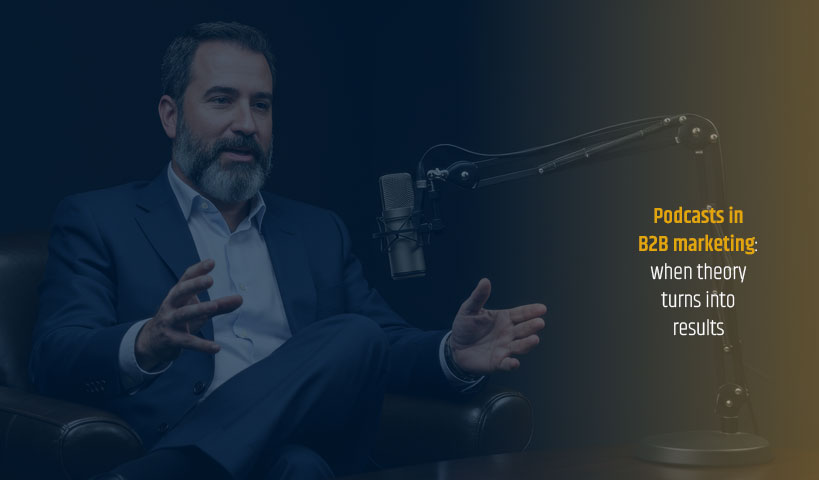
You’ve heard a lot about B2B content marketing. You’ve read that it has to be researched, strategized, developed, optimized and promoted. Oh, and why not do an overhaul of company culture while you’re at it, turning internal experts into regular content contributors.
But if you look up from your computer for a moment, inside your small to medium-sized business workplace, you quickly begin to wonder how you could collectively scrape up enough bandwidth to even sit down and talk about these kinds of strategies, let alone budget and implement them.
According to this stat from a 2017 report by the Content Marketing Institute, the majority of companies that have engaged in B2B content marketing either employ a small team or it’s basically a one-person show.
It’s likely where you are at today, and it certainly doesn’ t make B2B content marketing any easier.
Yet you know that quality content reaps benefits. It speaks to your customers, it moves them along the sales cycle and acts as a powerful SEO magnet.
So how can you benefit from content marketing with practically no resources?
Get ready to start B2B content marketing
Let me first whip out one finding from a recent CEB Gartner study on the power of content across the customer journey.
“The bulk of content consumption happens in the early stages of customer research, far from the purchase decision”
-source: Delivering on Marketing’s Promise to Drive Sales, CEB Gartner
The study found that the biggest content consumption in the sales cycle was happening when customers were understanding and evaluating solutions, even before they were considering a supplier (23%). At the low end of the B2B content marketing consumption scale was when they were selecting a supplier (18.6%) and when they were completing the purchase (13.4%).
This means that no matter how little time or money you have to devote to your B2B content marketing, you should be using it to strive to inform and educate through your content because that’s how potential customers are making the most use of it.
So let’s look at some shoestringy was to do that.
Optimize what you already have
Instead of going through the time-intensive process of creating brand new content, why not start by optimizing what you already have? Your website, product information, blog posts and presentations can always be improved upon. If you have immediate access to all this content, make the most of it. here’s how.
Inform and educate
In B2B, whether it’s communications, heavy industry, agriculture or manufacturing, the content that explains your products or services can be heavy reading. The thing is, your customers don’t only consist of mechanical or engineering experts. There are finance, logistics and service people, executives and management people who could be involved in the purchase process as well. Some of your content might seem downright arcane to them. Explain things in a popular science kind of way. Think about how your favorite science show explains stuff. Contrary to what some may believe, there is no loss in credibility in making things simple to understand.
And if you have to walk up to an expert in your company and ask him or her to explain it to you first, even better. The un-marketing words and phraseology he or she uses will probably resonate better with customers, and likely be keyword-rich too.
Use the customer’s perspective
Do the product descriptions on your website sound like “innovative, feature-rich, outstanding value”? This may well sound hollow to your customers. Even if your products truly are Innovative, these kinds of descriptions quickly wear thin on prospects because they don’t reveal much about the product, or your company. Oh, and everyone has heard them so often, they are sick to death of them. Just so you know.
You have to convert your content to your customer’s perspective. Pair down the superlatives and explain more about their problems and how your product will solve them. Sounds simple, yet just basking in your company’s environment day in and day out makes those superlatives become second nature. After a while, Goofy expressions like “the most innovative..” and “we are the market leaders in…” can actually seem quite normal to you. The antidote to this is a reality check with your customer’s pain points. You’ll quickly realize that “innovative” and “market leader” don’t solve any known customer problems. Have you spoken to any customers recently?
The next best thing is reading comments on the web or in social media about your, or similar products. Questions, debates, and frustrations are fertile ground for content creation.
Use web tools
Optimizing your content using web tools can help speed things up. If you work in WordPress (60% of everybody works in WordPress) you can use a powerful plugin like Yoast. It optimizes readability as well as SEO. Other good optimization tools include Google keyword planner and SEMrush.
Start attracting search engine attention now
Even if you can go in and optimize your website’s content at the rate of a web page or two per day, it will help your search rankings. Not in a matter of days, but weeks and months. If you keep at it though, you’ll reap the benefits. Optimizing your content makes your website fresher for those search engine robots. Particularly in B2B, optimizing a couple of pages a day likely changes your site more often than that of almost any of your competitors.
Stand out from your competitors, not from the entire world
Here’s another thing: Don’t get hung up on perfection. There’s no time for that. Your content doesn’t have to be more educational and more wonderful than anything that’s ever been done. It just has to be better and more interesting to your customers than that of your competitors. And you know what? in B2B, sometimes that isn’t so hard. It can seem surprising to the uninitiated, but many B2B businesses treat their websites like a catalog you can flip through. They aren’t really committed to conversion through the website, given that their traditional sales channels are still working better than ever. So, check out your competitor’s web sites. Look for customer pain points they don’t cover or that they just gloss over. If they claim a competency that’s yours, think about how you can nuance your abilities, so you can stand apart.
Master your subject matter
Sounds simplistic but you have to know what you are talking about. Otherwise, you’ll be stuck repeating the same clichés your competitors are. No amount of visuals will compensate for uninteresting content. You have to stand apart. The wider and deeper your knowledge about your industry and its customer experiences, the more you’ll be able to weave compelling stories around your subject matter and gain credibility. Also, if you are up to date in your industry knowledge, you’ll feel less sideswiped by new trends when they show up.
Research your key subjects. Read more. You know this whole internet thing is just a tool to sharpen your mind at differentiating the wheat from the chaff so buck up, and read more. Go to the industry news websites read the articles. Regularly. Read blog posts, ebooks and white papers. Read comments. These are often very enlightening because they enable you to peer into the brain of your prospects.
Stay up to date and form opinions. Your content has to go beyond trumpeting brand or product benefits. You must establish a solid backdrop of facts, stories, and opinions against which your company, your products, and services look like rock stars.
Dig deeper when developing social media content
If you decide to share content in social media, try to avoid sharing the same news as everyone else. An article will almost always have links to other articles or stats. Investigate and see if there is a story in that lesser known information. Digging deeper will often enable you to post articles that stand out from the competition.
Although I have no data to support this opinion, I tend to believe that the lack of social media engagement companies currently experience has a lot to do with the fact that little effort is being put into what articles they choose to share. What articles can you share that will make you stand out from the rest? What percentage of your social media activity is you actually doing or saying something unique? In social media, your B2B content marketing should be used to demonstrate what makes your company unique.
Fine. But where do I start?
What’s the easiest place for you to start? Your emails? Your social media accounts? The company website? Your blog? what are you waiting for? The important thing is to start and go steady. It is going to be a marathon, not a sprint so no need to get all ceremonial about where you start.
Ok, the best place to start is with content that is already getting the most attention. Choose your best performing content and keep refreshing and developing it. That’s where you’ll get the most out of your available bandwidth.
In line with your business goals, you want to attract customers. You want to make them keep coming back, keep consuming your content, and eventually become your customers. I hope these suggestions have given you some motivation to set about those tasks.
We’ve succeeded at B2B content marketing with our customers. We specialize in B2B marketing. Why not find out more?







